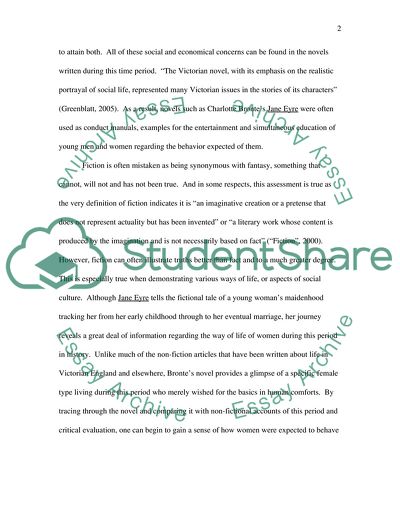Cite this document
(Jane Eyre: Conduct Manual Assignment Example | Topics and Well Written Essays - 4750 words, n.d.)
Jane Eyre: Conduct Manual Assignment Example | Topics and Well Written Essays - 4750 words. https://studentshare.org/literature/1723989-can-jane-eyre-be-used-as-a-conduct-manualin-the-1800s-novels-were-used-not-just-as-entertainment-but-as-a-sort-of-conduct-guide-to-the-young-men-and-women-who-read-them-when-looking-at-the-novel-from-this-perspective-the-character-of-jane-eyre-as-well
Jane Eyre: Conduct Manual Assignment Example | Topics and Well Written Essays - 4750 words. https://studentshare.org/literature/1723989-can-jane-eyre-be-used-as-a-conduct-manualin-the-1800s-novels-were-used-not-just-as-entertainment-but-as-a-sort-of-conduct-guide-to-the-young-men-and-women-who-read-them-when-looking-at-the-novel-from-this-perspective-the-character-of-jane-eyre-as-well
(Jane Eyre: Conduct Manual Assignment Example | Topics and Well Written Essays - 4750 Words)
Jane Eyre: Conduct Manual Assignment Example | Topics and Well Written Essays - 4750 Words. https://studentshare.org/literature/1723989-can-jane-eyre-be-used-as-a-conduct-manualin-the-1800s-novels-were-used-not-just-as-entertainment-but-as-a-sort-of-conduct-guide-to-the-young-men-and-women-who-read-them-when-looking-at-the-novel-from-this-perspective-the-character-of-jane-eyre-as-well.
Jane Eyre: Conduct Manual Assignment Example | Topics and Well Written Essays - 4750 Words. https://studentshare.org/literature/1723989-can-jane-eyre-be-used-as-a-conduct-manualin-the-1800s-novels-were-used-not-just-as-entertainment-but-as-a-sort-of-conduct-guide-to-the-young-men-and-women-who-read-them-when-looking-at-the-novel-from-this-perspective-the-character-of-jane-eyre-as-well.
“Jane Eyre: Conduct Manual Assignment Example | Topics and Well Written Essays - 4750 Words”. https://studentshare.org/literature/1723989-can-jane-eyre-be-used-as-a-conduct-manualin-the-1800s-novels-were-used-not-just-as-entertainment-but-as-a-sort-of-conduct-guide-to-the-young-men-and-women-who-read-them-when-looking-at-the-novel-from-this-perspective-the-character-of-jane-eyre-as-well.


